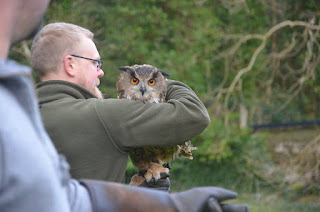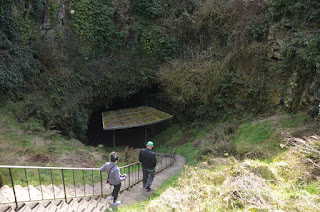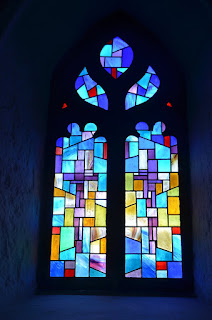This morning, Josh and I drove all the way across Ireland…. in
a total of two hours. The great part
about driving this leg of the trip on a Sunday morning was that the only thing
we had to slow down for was roundabouts.
Have I mentioned they have them everywhere? They do.
By the hundreds. They have every
flavor of roundabout that I have yet seen across the world, from multi-lane ones
a la Paris to ones with stop lights in the middle in the style of Washington
D.C. (which defeats the purpose, right?).
Anyway, we arrived in Dublin with plenty of time to poke around.
We started our Dublin adventure at Kilmainham Gaol. That last word is pronounced “jail” because, funnily
enough, it was a jail for a century and a half.
From 1799 until 1924, prisoners were housed in Kilmainham Gaol for a
variety of offenses. There were people
who were deported via the jail (over 4,000 to
Australia), people arrested for petty crimes, and a healthy dose of political
prisoners (about 10% of the inmates most years).
Interestingly, when it opened, the prison accepted both men and women,
and women ended up in jail nearly as often as men did. Until they stopped allowing women into the jail,
over 40% of the inmates were women every year but one. This has been attributed to the reduced
economic opportunities for women, as well as the reduced marriage opportunities
once all the healthy young lads fled Ireland after the Famine. Ladies became ladies of the night because
they couldn’t catch a break. There was
also a substantial rise in the number of inmates during the Famine, since the
jail provided a shelter and at least a meager ration. As George Bernard Shaw wrote, “If the prison
does not underbid the slum in human misery, the slum will empty and the prison
will fill.” Guess what? He was right. The final reason that occupancy increased was
annual – the Donnybrook Fair, to be precise.
Drunken and disorderly behavior hit a peak each year during the horse
fair and the jail got rowdy and full.
Ah, the Irish.
Anyway, the Kilmainham Gaol
is most famous for its political prisoners, most of whom were involved in Irish
rebellions against the British Crown.
The tour of the jail focuses largely on these inmates and their stories. In fact, after the jail was abandoned in the
1920s, it was a former inmate (he was actually imprisoned there twice) who officially
commemorated the 50th anniversary of its closure and reopened it to
the public. By that time, though, he
had become the head of Ireland.
Definitely an interesting place to visit with a great tour. Highly recommend!
Our next stop was another Dublin classic, Trinity
College.
Though not as old as Dublin
(founded 988 AD), Trinity College Dublin is still pretty darn old (founded 1592
AD). Josh and I went on one of the
student-led tours, which also included admission to the old library to see the
Book of Kells. Our student tour guide
was HILARIOUS. He described the boring
naming of the squares, the numerous architectural mishaps over the years, the
best and worst places to live on campus (only 800 of the 18,000 students can be
housed on campus, but one of the buildings that you “luckily” get assigned
requires running outside in your robe and queuing for the shower), and many
other tidbits. Josh and I were thrilled
to see that they had a buttery, just like at Yale.
After the tour, we went to see the Book of Kells (no photography allowed) in the Old Library.
Fun fact: the books here are arranged not by author, title, or year of publication, but by size. If you look at the shelves, you'll see they have different heights based on their contents.
Basically, the Book of Kells is a really, really old (approx. 9th century) illuminated manuscript in Latin that
covers the four gospels of the Bible.
Between the numerous typos and the gorgeous, detailed decorations, they’re
pretty sure it was just for show and not for everyday use. It is beautiful, though. The lavish decorations are so detailed that
scholars wonder if they used some sort of magnifying lens as they worked on it. The book is named after its home at Kells, in
the county Meath. However, it has found
its home in Dublin since 1653. It was
sent there for safekeeping, which was no surprise since the buildings of the
monastery at Kells burned down every 5-10 years for several decades around the
1000s and were pillaged several times.
It’s a wonder they didn’t send it over sooner, although perhaps early
Dublin was a rough town. Regardless, the
manuscript is beautiful and I’m glad that monks had seemingly endless patience
in the 9th century to do this kind of work.
Our plan was to head to the Christ Church Cathedral next, as
it is just down the road from Trinity College.
Alas, our arrival coincided with the 3:30 PM evensong and we were not
allowed to enter.
The final item on our agenda for the evening - and our trip to Ireland - was meeting up with two of my fellow students at a pub. They have been traveling Ireland for two whole weeks and this was the one day that we overlapped. Again, it was one of those evenings that stretched for hours until, at last, we had to head back to our hotel and grab some sleep.
(At least, that was the plan until we arrived at our hotel and found out that Sunday night is live music night at a spot right outside our window, so we will be up until at least midnight. It's like the jetlag gods are trying to make us adjust.)
Until next time, Ireland.
Spotted: Punny names! Dublin establishments that have received the
Jessica stamp of approval include Pitta Pan, Queen of Tarts, and Abra Kebabra.
Spotted #2: The 100th anniversary of the 1916 Easter Rising. This was a major turning point in public opinion regarding the relationship of Ireland and Britain. While the uprising didn't receive wide support, the perceived overreaction of the British in punishing those involved in the uprising helped the Irish people unite around independence. We found out today that the Irish flag actually represents these dueling sentiments. The green represents the revolutionaries who wanted to split from Britain, the orange represents those who wanted to stay loyal to the Crown, and the white represents the peaceful resolution of their differences.












































